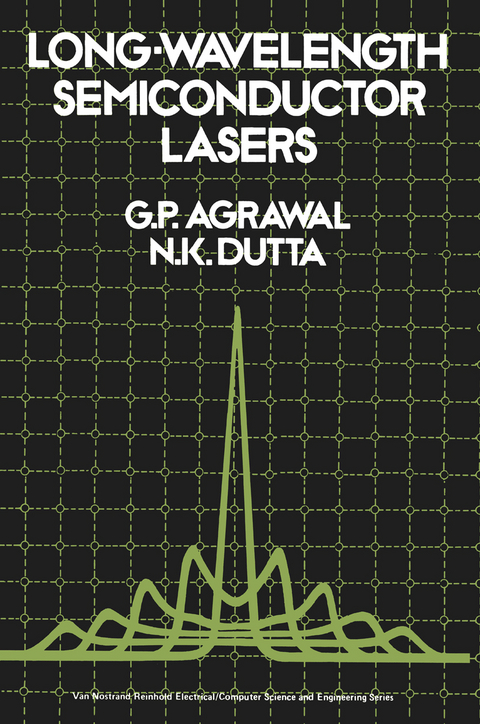
Long-Wavelength Semiconductor Lasers
Springer (Verlag)
978-94-011-6996-7 (ISBN)
1. Introduction.- 1.1 Historical Perspective.- 1.2 Semiconductor Materials.- 1.3 Operating Principles.- 1.4 Optical Fiber Communications.- 1.5 Overview.- References.- 2. Basic Concepts.- 2.1 Introduction.- 2.2 Maxwell’s Equations.- 2.3 Threshold Condition and Longitudinal Modes.- 2.4 Gain and Stimulated Emission.- 2.5 Waveguide Modes.- 2.6 Emission Characteristics.- References.- 3. Recombination Mechanisms in Semiconductors.- 3.1 Introduction.- 3.2 Radiative Recombination.- 3.3 Nonradiative Recombination.- 3.4 Experimental Results.- 3.5 Threshold Current Density.- 3.6 Temperature Dependence of Threshold Current.- References.- 4. Epitaxy and Material Parameters of InGaAsP.- 4.1 Introduction.- 4.2 Liquid-Phase Epitaxy.- 4.3 Vapor-Phase Epitaxy.- 4.4 Metal-Organic Vapor-Phase Epitaxy.- 4.5 Molecular-Beam Epitaxy.- 4.6 Lattice-Mismatch Effects.- 4.7 Material Parameters.- References.- 5. Laser Structures and Their Performance.- 5.1 Introduction.- 5.2 Broad-Area Lasers.- 5.3 Gain-Guided Lasers.- 5.4 Weakly Index Guided Lasers.- 5.5 Strongly Index Guided Lasers.- 5.6 Leakage Current.- 5.7 Laser Arrays.- 5.8 Surface-Emitting Lasers.- References.- 6. Rate Equations and Operating Characteristics.- 6.1 Introduction.- 6.2 Rate Equations.- 6.3 Steady-State Characteristics.- 6.4 Transient Response.- 6.5 Noise Characteristics.- 6.6 Modulation Response.- 6.7 External Optical Feedback.- References.- 7. Distributed-Feedback Semiconductor Lasers.- 7.1 Introduction.- 7.2 DFB Laser Structures.- 7.3 Theory.- 7.4 Performance.- 7.5 DBR Lasers.- 7.6 Transmission Experiments.- 7.7 Concluding Remarks.- References.- 8. Coupled-Cavity Semiconductor Lasers.- 8.1 Introduction.- 8.2 Coupled-Cavity Schemes.- 8.3 Theory.- 8.4 Operating Characteristics.- 8.5 Diverse Applications.- References.- 9.Quantum-Well Semiconductor Lasers.- 9.1 Energy Levels.- 9.2 Density of States.- 9.3 Experimental Observation of Confined States.- 9.4 Radiative Recombination.- 9.5 Auger Recombination.- 9.6 Single-Quantum-Well and Multiquantum-Well Lasers.- 9.7 Experimental Results.- 9.8 Modulation and Noise Characteristics.- References.- 10. Degradation and Reliability.- 10.1 Introduction.- 10.2 Defect Formation in the Active Region.- 10.3 Catastrophic Degradation.- 10.4 Degradation of Current Confining Junctions.- 10.5 Reliability Assurance.- References.- 11. Lead-Salt Semiconductor Lasers.- 11.1 Introduction.- 11.2 Materials and Physical Properties.- 11.3 Band Structure.- 11.4 Optical Gain.- 11.5 Auger Recombination.- 11.6 Laser Diode Fabrication.- 11.7 Laser Properties.- 11.8 Tuning Characteristics.- 11.9 Other Material Systems.- References.- Epilogue.
| Reihe/Serie | Van Nostrand Reinhold Electrical/Computer Science and Engineering Series |
|---|---|
| Zusatzinfo | 37 Illustrations, black and white; XIII, 474 p. 37 illus. |
| Verlagsort | Dordrecht |
| Sprache | englisch |
| Maße | 152 x 229 mm |
| Themenwelt | Schulbuch / Wörterbuch |
| Geisteswissenschaften | |
| Naturwissenschaften | |
| Sozialwissenschaften | |
| Technik ► Elektrotechnik / Energietechnik | |
| ISBN-10 | 94-011-6996-9 / 9401169969 |
| ISBN-13 | 978-94-011-6996-7 / 9789401169967 |
| Zustand | Neuware |
| Haben Sie eine Frage zum Produkt? |
aus dem Bereich


